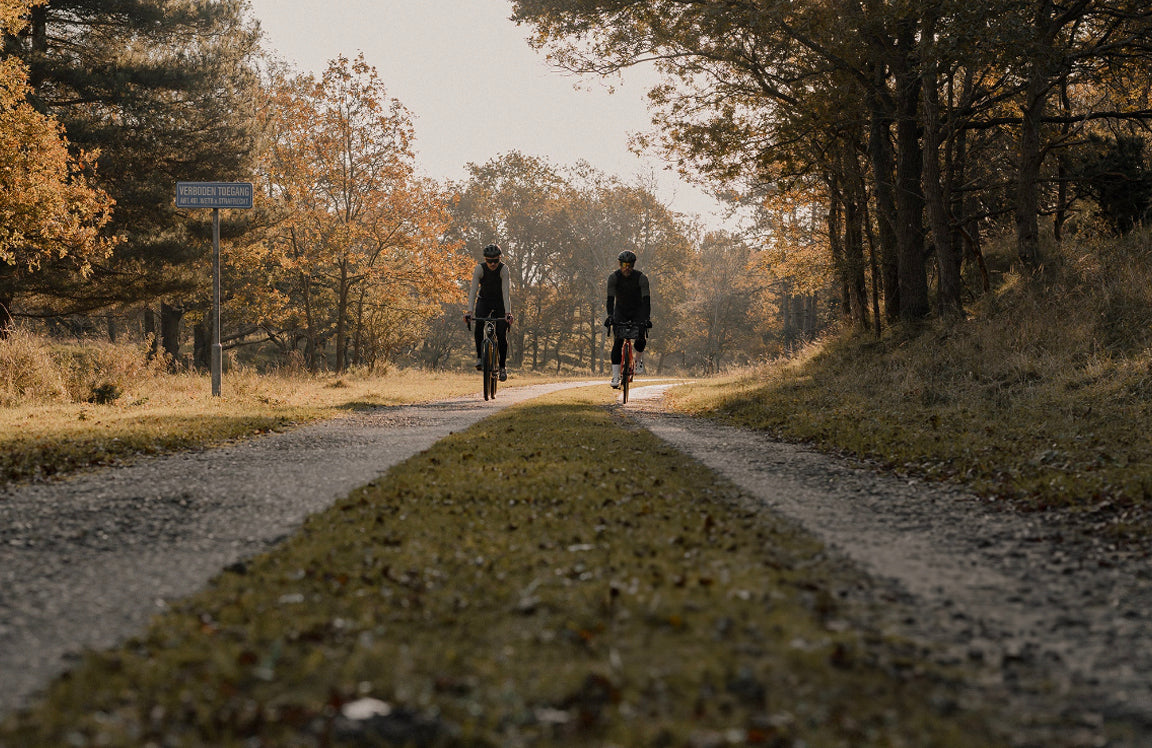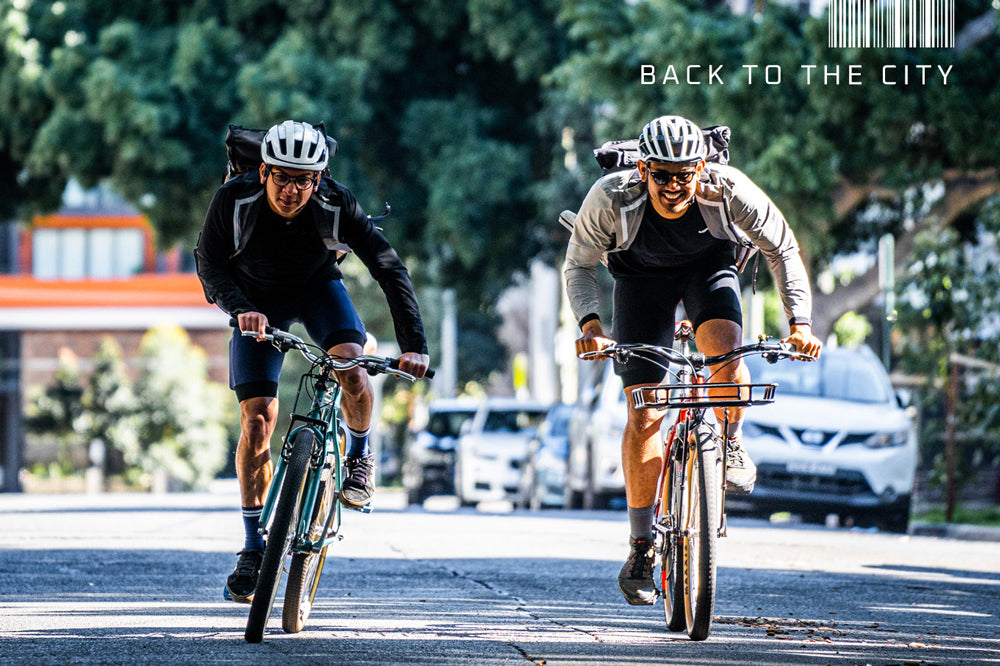Cycling Back pain Management Tips & Tricks
Words: Scott Macallister & Charlie Coquillard / Pictures: Charlie Coquillard
Part 2 | SOOMOM'S PAIN MANAGEMENT FOR CYCLISTS SERIES
With EJ Macdonald | Exercise Scientist
Introduction
Is there anything more uncomfortable while cycling than lower back pain?
Imagine sitting slumped at a desk for hours while tensing your legs and upper body, without changing position.
It’s fair to say you’d feel pretty stiff and sore after that, but that is essentially your position while cycling.
Unfortunately, unless you want to be as aero as a boat sail and sit upright on the bike, it’s this position that leads to many cycling enthusiasts and professionals complaining of lower back pain after a ride.
Commonly, back pain from cycling occurs in the lower back region (erector muscles) or the mid back region (trapezius muscles).
These two muscle groups are put under the greatest strain when held static in one position for an elapsed period of time.
Exercise scientist EJ MacDonald is here to help relieve your lower back discomfort with the help of some simple exercises and stretches to incorporate into your daily routine.
What We’ll Cover in this Article
- Most common causes of cycling lower back pain
- Stretches & Exercises for cycling lower back pain (golden stretches & exercises)
- How to avoid lower back pain from cycling

Hey I'm E.J
I'm a former World championship athlete and an exercise Scientist from the university of Wollongong.
I am currently working with cycling team : Team Bridgelane.
I have teamed up with Soomom apparel to create a series of 3 episodes, targeted at preventing and treating common pain cyclists experience, namely knee, back and neck pain.
By giving you access to a comprehensive series of exercise, I hope to keep you healthy on the bike!
Read more about how EJ trains and what it takes for female riders to reach the next level in their cycling.
Most common causes of cycling lower back pain
The most common type of discomfort for cyclists is described as pain in the lower region of the back, or the extensor muscles which are responsible for supporting our back in an upright position.
More often than not it’s a result of a combination of issues, however there’s 2 main reasons for lower back pain in cyclists that we will explore.
There's discomfort caused by incorrect bike fit, and issues with hip mobility, muscle strength and flexibility.
Bike Fit & Equipment
First point of call when it comes to niggles on the bike is making sure you’re riding the correct frame size or position.
While a professional bike fit isn’t always necessary, there are a few quick fixes you can check at home with just a mirror or with the help of someone else.
A saddle that’s too high causes your hips to rock back and forth in order to reach the bottom of the pedal stroke.
This results in stretching of the erector muscles or posterior chain each time you pedal. As a rough rule of thumb, there should be a slight bend in the knee when your pedal is at 6 o’clock, or the bottom of the stroke.
If your leg is completely extended then lower your seat height so there’s a 20 – 30 degree bend in your knee flexion.
If you have a nice bend in your knee and stable hips when pedalling, it might be helpful to check how far away your handlebars are from the seat.
If the distance is too long it causes an over-stretched position that puts strain on the lower back.
Using a shorter stem or adding height to the handlebars can achieve a more upright position.
Speak to your local bike mechanic or seek out a professional bike fit to ensure your bike is setup correctly for your body size.
With the correct bike position sorted it’s important to look at the foundation of your position on the bike.
This article will be focused on the exercises you can do to treat and recover from lower back pain from cycling.
Incorrect bike fit can also affect other areas of the body, we have covered cycling knee pain and cycling neck pain also as part of this series.
Hip Mobility & Lower back Muscle Strength
These exercises will be focused on your hip mobility and the strength endurance of the lower back muscles, or erector group.
During the pedalling motion your core steadies the pelvis and provides resistance for your legs to push against on the down stroke.
It goes hand in hand then that a strong core will allow you to produce more power, while a weaker core forces the lower back muscles to work overtime to compensate.
This results in muscle fatigue and eventually pain in the lower back region.
The key areas we’ll address in treatment and prevention will be building your strength and mobility in the hips and erector muscles.
If you ever find yourself rocking in your saddle especially as you fatigue, it’s important to assess if lower back muscle weakness is a cause.
Follow the short strengthening program below consistently and you’ll notice decreased lower back pain and improved pedaling power.
Stretches & Exercises for cycling lower back pain
Prevention is always better than the cure so it’s important to ensure you’ve covered all bases before jumping on the bike if you have recently experienced lower back pain.
There’s no use spending time exercising muscle groups to support your lower back if you jump back onto a bike that isn’t setup for your personal requirements.
Bike Fit & Saddle Position
Note: When it comes to treatment and prevention of lower back pain in cycling, it’s key to note that if there’s any sudden, sharp pain or pins and needles in your back region, it’s important to seek professional opinion.
Being such a crucial part of the human body the last thing anyone needs is aggravation or long-term issues arising from self-treatment or misdiagnosis.
We’ve mentioned bike setup, and it remains important, but another aspect that can be considered while cycling is how you sit on your saddle.
While cycling it’s important to have your spine in a neutral position with as minimal curve possible through the mid and lower back.
By trying to tilt the top of your pelvis forward towards the ground it will reduce flexion and bring your hips in line.
To maintain this position you will need to build up good core stability.
Check out our bike fit series to learn how you can make sure your setup is perfect for your body's individual needs.
Once these bike and saddle position foundations are addressed, the next step is to build some additional core strength to support your saddle position.
Building Core Stability
Core stability provides the opposing resistance required to push against force generated by each pedal stroke.
Without this you will notice rocking of the hips and uncontrolled movements in the upper body with each pedal stroke.
This is due to your trunk being too weak to absorb forces from the legs that causes a chain reaction that will shift your spine out of alignment.
The fatigue caused by this motion will lead to an increased likelihood of lower back pain.
Some important core exercises you can implement to counteract this are;
Pelvic Tilts

Starting in a plank position on both elbows draw in your abdominal muscles and slowly start to rotate the pelvis backwards.
This flattens your lower spine parallel with the floor. Reverse the movement by rolling your pelvis forwards.
Hold each position for 10 seconds, repeat
Alternate Arm/Leg Extensions

Lying flat on your back, either on the ground or flat surface, draw in your lower abdominals and slowly raise one leg and the opposite arm out.
Keep the remaining leg and arm on the ground by your side.
Maintain a neutral spine and pelvic position.
Perform slowly making sure the core is switched on and stabilised.
Plank

After mastering the above exercises, completing them without using your lower back or pelvis shift, you can progress to a plank exercise.
With weight on your elbows and feet, ensuring your back is in a neutral position, parallel to the floor and hips in line.
Draw in your abdominals, hold for 30 seconds to a minute and repeat.
If you find your back sagging or hips raising, complete instead with your knees on the ground instead of feet

While cycling, have your spine in a neutral position with as minimal curve through the mid and lower back.
How to avoid lower back pain from cycling
So how do we prevent lower back pain from recurring after treatment?
With the correct bike fit, a better saddle and a core strengthening plan in place we want to add in a program to build strength in the lower back.
These exercises to build lower back strength for cyclists fall into two categories;
- Those that Build Strength
- Those that Improve Flexibility
Phase One; Exercises to Build Strength
To increase lower back strength we want to target muscles that are able to support the body when extended, or in a forward position like on the bike.
It’s important to target increased strength in this block, however it’s also important to build endurance to support the back for extended periods.
Some key muscle groups we need to target are the lower back, glutes, hamstrings, and hip flexors.
Four key exercises to incorporate into a daily routine to build strength in these muscles are;
Lying Leg Lifts

Bridges

Superman with leg lifts

Superman plank with leg lifts

Phase Two; Exercises to Increase Flexibility
To increase lower back flexibility we target muscles that reduce tension in the lower back.
As you bend further forward this rigidity results in the lower back tightening up at the end of its range while in a static position.
By releasing these areas, and improving flexibility, there will be less strain on the erector muscles, reducing the risk of inflammation, sprains, or fatigue.
Four key stretches to incorporate into a daily routine to build flexibility in these muscles are;
Lying Figure Four Stretch

Lying Trunk Rotation

Cat Cow Stretch

Seated Hamstring Stretch

Conclusion
The lower back is an area of concern for cyclists as they spend so long sitting in a stationary position, moving only the legs below.
It’s also the platform from which your legs drive downward power onto the pedals.
So, the stronger the lower back region the greater the pedaling power a cyclist can generate.
Make sure you take discomfort and pain seriously when it occurs and take the time to assess how you can avoid long term problems.
EJ’s tips provide a great background for cyclists experiencing this common issue, but if pain persists always consult a medical professional directly.
Keep your eye out for more articles in this series as we aim to help cyclists conquer their bodies so they can keep conquering those climbs.
Checkout the full blog series here covering the key areas of pain management for cyclists.
Take a look at Soomom's blogs or follow us on Instagram for more in depth cycling news and tips.
More Stories
Cycling Brings Two Soomom Ambassadors Together
Social media can help you find people who share the same passion and connect with them. You can build these connections all over the world through our virtual playgrounds, but there are many cases where you can expand those horizons and really meet up in person.
Soomom X Mulga : Limited edition Artist series
Sydney Artist's Mulga loves to create funky and colorful animals, bringing joy to everyone passing by his art. Inspired by his coastal lifestyle, he brings a bright twist to some of the coolest specimens in the animal kingdom.
Back to the City
To celebrate the end of lockdown as people slowly head back to the city in Australia, Soomom wants to highlight an under-appreciated segment of the cycling fraternity: The Courier.



